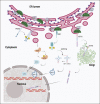Emerging Role of Exosomal-Derived Long Noncoding RNAs in Human PDAC
- PMID: 35295891
- PMCID: PMC8874243
- DOI: 10.1159/000520947
Emerging Role of Exosomal-Derived Long Noncoding RNAs in Human PDAC
Abstract
Background: The incidence and mortality of pancreatic ductal adenocarcinoma (PDAC) are increasing recently. Most patients with PDAC are diagnosed at advanced stage because of the high invasiveness of cancer cells and the lack of typical early symptoms. Therefore, early diagnosis of PDAC is very important to improve the prognosis. Exosomes play crucial role in intercellular communication and deliver the contents to recipient cells to regulate their biological behaviors. Recent evidence suggests emerging role of exosomes in the carcinogenesis of a variety of cancers including PDAC. Long noncoding RNAs (LncRNAs) have been reported to be involved in the development of PDAC. It has been proved that LncRNAs have the potential to be biomarkers and therapeutic targets for PDAC. Moreover, increasing number of studies focus on the role of exosomal LncRNAs in PDAC.
Summary: In this review, we summarize the current status on our understanding of the role of exosomal-derived LncRNAs in the progression and metastasis of PDAC.
Key messages: We focus on challenges in the potential of exosomal-derived LncRNAs as novel diagnostic and prognostic markers and therapeutic targets of PDAC. In addition, we provide an overview about the demonstrated important role of exosomal LncRNAs in the progression of PDAC.
Keywords: Exosomes; Long noncoding RNAs; Pancreatic cancer; Pancreatic ductal adenocarcinoma.
Copyright © 2021 by S. Karger AG, Basel.
Conflict of interest statement
The authors declare no conflicts of interest.
Figures


References
-
- Chen X, Yi B, Liu Z, Zou H, Zhou J, Zhang Z, et al. Global, regional and national burden of pancreatic cancer, 1990 to 2017: results from the Global Burden of Disease Study 2017. Pancreatology. 2020;20((3)):462–9. - PubMed
-
- Ariyama J. [Detection and prognosis of small pancreatic ductal adenocarcinoma] Nihon Geka Gakkai Zasshi. 1997;98((7)):592–6. - PubMed
-
- Yamashita Y, Kitano M, Ashida R. Value of endoscopy for early diagnosis of pancreatic carcinoma. Dig Endosc. 2020;32((1)):27–36. - PubMed
Publication types
LinkOut - more resources
Full Text Sources

